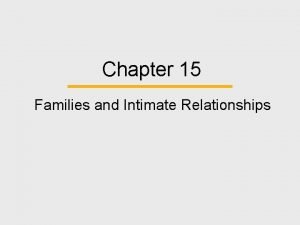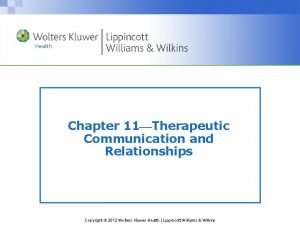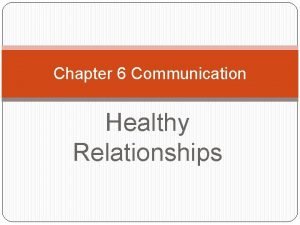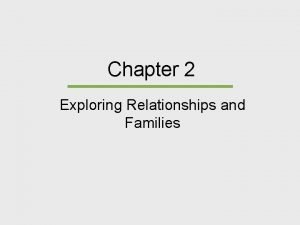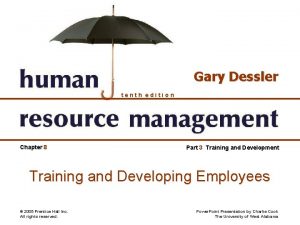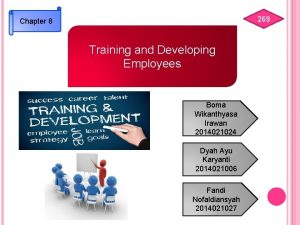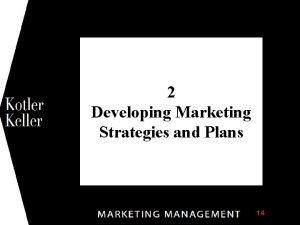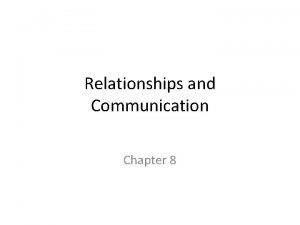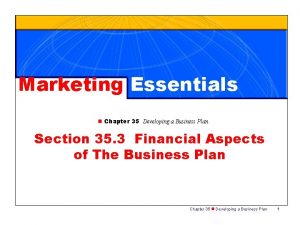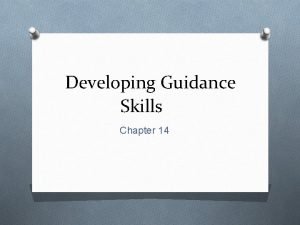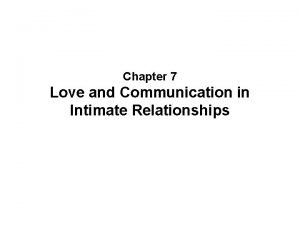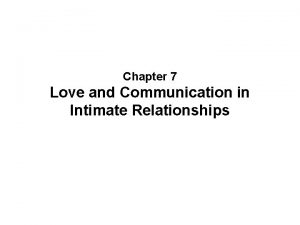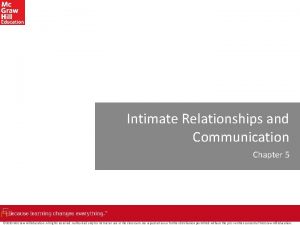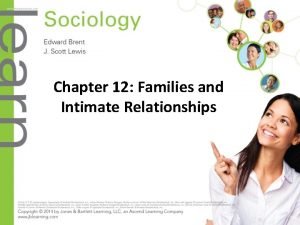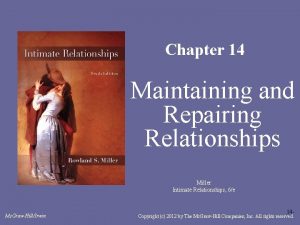Intimate Relationships and Communication Chapter 4 Developing Intimate































- Slides: 31

Intimate Relationships and Communication Chapter 4

Developing Intimate Relationships v Successful Relationships require: – Positive Self-concept and Self-esteem • • • developed in infancy and childhood gender roles attachment adult styles of loving less than ideal childhood can still have a successful relationship 2

Developing Intimate Relationships v Successful Relationships require: – Friendships • based on companionship, respect, acceptance, help, trust, loyalty and reciprocity • may be longer lasting and more stable 3

Love, Sex, and Commitment One of the most basic and profound human emotions. v These 3 are linked ideals in intimate relationship. v Characteristics of love, sex and commitment. v 4

Sternberg’s Classifications of Love v Based on degrees of intimacy, passion and commitment: – – – – Liking Infatuation Romantic Fatuous Empty Companionate Consummate 5

6

The Pleasure and Pain of Love v Recognize the human emotions – Two components: 1. Physiological arousal 2. Emotional explanation 7

The Transformation of Love All relationships change over time. v High levels of passion. v Growth of intimacy. v Reduction of romance and or passion to the transformation of deep love. v 8

Stresses on a Intimate Partnership Unequal or Premature commitment v Unrealistic Expectations v Competitiveness v Balance of Time together and apart v Jealousy v 9

Successful Relationships Realistic expectations v Mutual trust v Open communication v Effective ways to resolve conflict v Agreement on religious/ethical values v Equal roles v Balance of individual and joint interests v 10

Ending a Relationship Reasons why? v Guidelines of a breakup v – Fair chance – Be fair – Be tactful – Time for resolving your anger and pain – The value of the experience 11

Communication Nonverbal v Ability to interpret nonverbal messages v Self-disclosure v Listening v Feedback is a constructive response v Gender differences in communication v 12

Conflict and Conflict Resolution v Conflict resolution skills are vital for maintaining intimate relationships. 1. 2. 3. 4. 5. 6. Clarify the issue. Find out what each person wants. Identify various alternatives. Decide how to negotiate. Solidify the agreements. Review and negotiate. 13

Pairing and Singlehood v Choosing a Partner. – Attraction. – Similarities. – Communication. – Acceptance. 14

Dating Different cultures have different rituals for finding a mate. v American Culture. v – Getting to know each other. – Traditional male-female dating pattern. – Dating of young people. 15

Cohabitation Factors of acceptance v Rarely continues indefinitely v Advantages v Liabilities v 16

Partnership v Gay and Lesbian – Sexual orientation – Homosexual relationships in relation to heterosexual relationships – Traditional gender roles – Societal attitudes 17

Singlehood Diverse group v Factors that contribute to a growing number v Advantages v Disadvantages v Enjoyment depends upon: v 18

19

Marriage Benefits of Marriage v Issues of marriage v Role of Commitment v 20

Divorce v High rates. . Why? – Process of Divorce. • Physical separation. • Emotional separation. – Greatest stress producing event next to the death of a spouse. – Recovery from divorce. – Remarriage. 21

Family Life v v v Becoming a Parent Family life cycle Preparation for parenthood – Own stability and readiness to be a parent – Physical health – Teenage parenting – Over the age of 35 – Nutritional habits – Genetics – Financial – Considered educational and career plans – Emotionally ready – Social support – Attitudes and aptitudes 22

Preconception Care v v Preexisting medical condition Current use of medications and drugs Use of tobacco and/or alcohol Past problems with pregnancy v v v Disease risks and immunization history Dietary habits Family history of genetic diseases or multiple births 23

Birth of First Child Stressful transition v Return to traditional gender roles v Each stage of the Family Life Cycle – New parents: v • worry about choices and mistakes • no set rules • most important is to promote satisfaction for all family members. 24

Birth of First Child Later stages: balance between giving freedom and setting limits v Marital satisfaction tends to decline when children are in school v 25

Building Blocks of Parenting Modeling v Trust v Respect v Love and Discipline v Honesty v Positive Statements v Time, Attention, Concern v 26

Single-parent Families Differences to a traditional family life cycle. v Difficulties experienced as a single parent. v Single Fatherhood. v Children from single-parent families. v 27

28

Stepfamilies or Blended Families v v 3 out of 4 women and 4 out of 5 men will remarry. Should not be expected to duplicate the emotions and relationships of an intact family. Healthy stepfamilies are less cohesive and more adaptable than healthy intact families. Allow for more individual differences. More of a history they have the more of a family unit is built. 29

Qualities of Successful Families Commitment v Appreciation v Communication v Time together v Spiritual wellness v Coping with stress and crisis v 30

31
 Love and communication in intimate relationships
Love and communication in intimate relationships Define the relationship ch 7
Define the relationship ch 7 Intimate relationships, marriages, and families 9th edition
Intimate relationships, marriages, and families 9th edition Intimacy after incarceration
Intimacy after incarceration Intimate zone in communication
Intimate zone in communication Intimate zone in communication
Intimate zone in communication Chapter 6 communication and relationships
Chapter 6 communication and relationships Intimate family chapter 6
Intimate family chapter 6 Intimate family chapter 6
Intimate family chapter 6 The essence of marriage chapter 2
The essence of marriage chapter 2 Intimate family chapter 2
Intimate family chapter 2 Chapter 8 training and developing employees
Chapter 8 training and developing employees Chapter 2 developing marketing strategies and plans
Chapter 2 developing marketing strategies and plans Chapter 8 training and developing employees
Chapter 8 training and developing employees Developing and managing products
Developing and managing products Ilumination
Ilumination Intimate distance definition
Intimate distance definition Example consultative register
Example consultative register Dewgarden foaming intimate wash benefits
Dewgarden foaming intimate wash benefits Scary antonym
Scary antonym Me line 02 intimate
Me line 02 intimate Relationship guidelines chapter 8
Relationship guidelines chapter 8 Periwinkle doerfler
Periwinkle doerfler Stages of relationships communication
Stages of relationships communication Chapter 35 developing a business plan
Chapter 35 developing a business plan Chapter 15 developing fraction concepts
Chapter 15 developing fraction concepts Developing guidance skills
Developing guidance skills Chapter 35 developing a business plan
Chapter 35 developing a business plan Chapter 17:4 participating in a job interview
Chapter 17:4 participating in a job interview Chapter 3 lesson 1 developing your self esteem
Chapter 3 lesson 1 developing your self esteem Vast wilderness
Vast wilderness Total product offer
Total product offer


